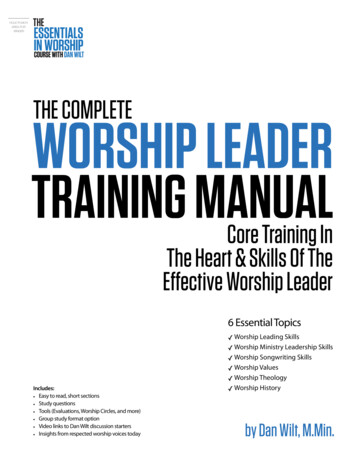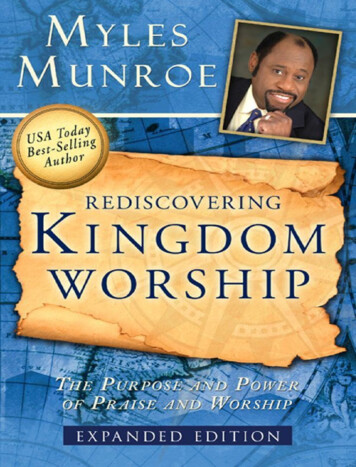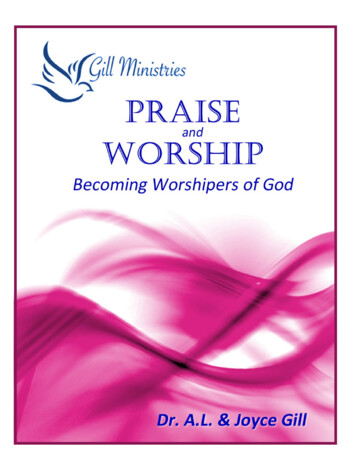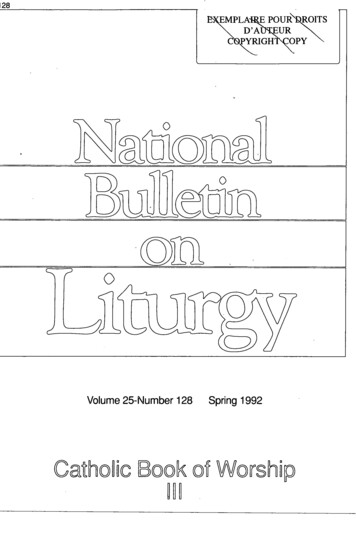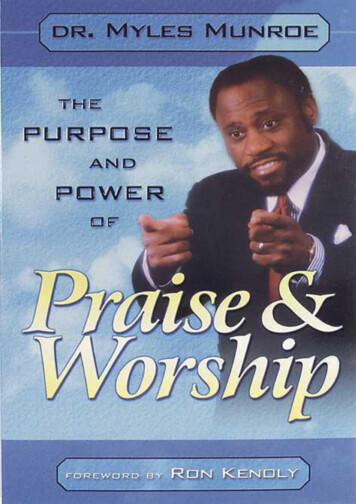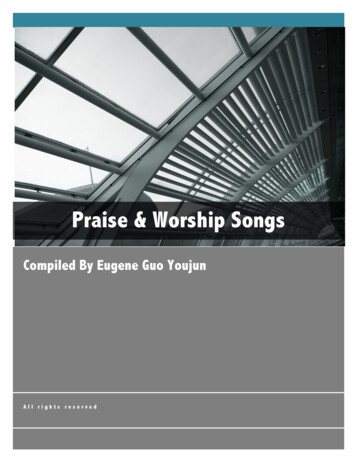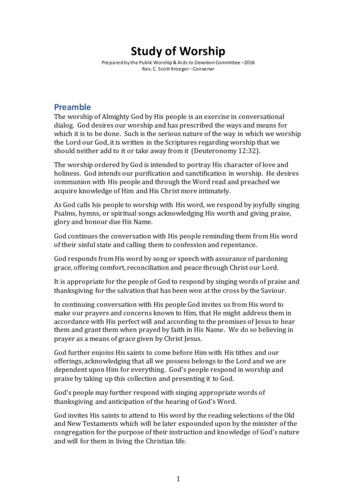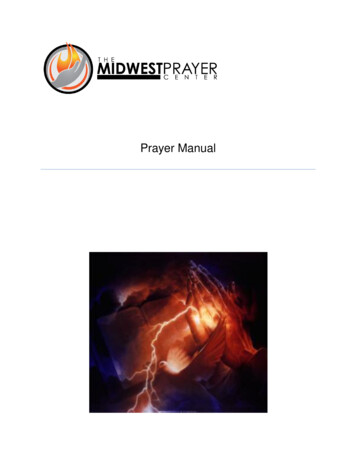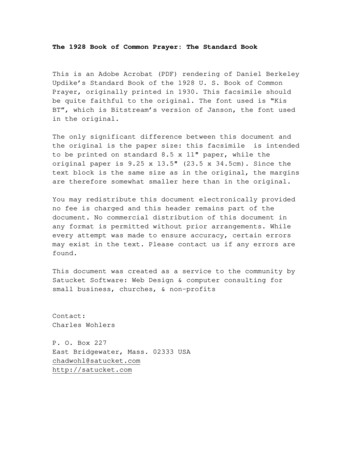
Transcription
00 FMT (i-viii, 1-14)2/18/0512:33 PMPage iBOOK OFCOMMONWORSHIP
00 FMT (i-viii, 1-14)2/18/0512:33 PMPage iiiB OOK OFC OMMONW ORSHIPPREPARED BYTHE THEOLOGY ANDWORSHIP MINISTRY UNITFOR THEPRESBYTERIAN CHURCH (U.S.A.)AND THECUMBERLAND PRESBYTERIAN CHURCHCommended by the 205th General Assembly (1993)of the Presbyterian Church (U.S.A.) and the 163rdGeneral Assembly (1993) of the CumberlandPresbyterian Church for use in worship.
00 FMT (i-viii, 1-14)2/18/0512:33 PMPage iv 1993 Westminster/John Knox PressAll rights reserved. No part of this publication may be reproduced without special permission, except as noted.Brief portions of this Book of Common Worship may be reproduced without special permission for one-time use only, for worship and educational purposes, in an order of servicefor use by a congregation, or in a special program or lesson resource, provided that no partof such reproduction is sold, directly or indirectly, and that the following acknowledgmentis included: Reprinted by permission from Book of Common Worship, 1993Westminster/John Knox Press.The Easter Vigil music on pages 299–302, and the psalm refrains on pages 609–610, maybe reproduced in an order of service for a congregation for one-time use only.Inquiries concerning rights and reproductions not herein authorized should be directedto Westminster/John Knox Press, 100 Witherspoon Street, Louisville, KY 40202-1396.For Acknowledgments, see pages 1099–1106.Published by Westminster/John Knox PressLouisville, KentuckyThis book is printed on acid-free paper that meets the American National StandardsInstitute Z39.48 standard.Book design by Susan E. JacksonInterior illustrations by Aavidar Design Inc.PRINTED IN THE UNITED STATES OF AMERICA9 8 7 6 5 4 3 2 1Library of Congress Cataloging-in-Publication DataA catalog record for this book is available from the Library of Congress.ISBN 0-664-21991-8
00 FMT (i-viii, 1-14)2/18/0512:33 PMPage vCONTENTSPREFACE1ABBREVIATIONS14PREPARATION FOR WORSHIPPrayers for Use Before Worship17The Law of God28Prayers for Worship Leaders29THE SERVICE FOR THE LORD’S DAYBasic Movement of the Service for the Lord’s Day33The Service for the Lord’s Day: A Descriptionof Its Movement and Elements34The Service for the Lord’s Day: Order with Liturgical TextsAdditional Texts for the Service for the Lord’s Day87Prayer of Confession87Prayer for Illumination90Ascription of Praise91Invitation to Discipleship92Affirmation of Faith94Prayers of the People: A–H99Commemoration of Those Who Have Died in the FaithPrayers of the People: Concluding Collects123Invitation to the Lord’s Table125Great Thanksgiving: B–J126Prayer After Communion15748121Contents/ v
00 FMT (i-viii, 1-14)2/18/0512:33 PMPage viPrayer of Thanksgiving158Charge to the People159Blessing161RESOURCES FOR THE LITURGICAL YEARAdvent165Christmas178Epiphany—January 6191Baptism of the Lord198Sundays Between Baptism of the Lordand Transfiguration of the Lord205Transfiguration of the Lord214Ash Wednesday221Lent235Passion/Palm Sunday252Maundy Thursday269Good Friday281The Great Vigil of Easter294Easter Sunday Through Seventh Sunday of Easter315Day of Pentecost338Trinity Sunday348Sundays Between Trinity Sunday and Christ the King354Christ the King (or Reign of Christ)394BAPTISM AND REAFFIRMATION OF THE BAPTISMAL COVENANTThe Sacrament of Baptism403An Alternative Service for the Sacrament of Baptism419Baptism and Reaffirmation of the Baptismal Covenant:A Combined Order431Reaffirmation of the Baptismal Covenant for ThoseMaking a Public Profession of Faith447Reaffirmation of the Baptismal Covenant for ThoseUniting with a Congregation455Reaffirmation of the Baptismal Covenant for a Congregation464Reaffirmation of the Baptismal Covenant MarkingOccasions of Growth in Faith478Reaffirmation of the Baptismal Covenant in Pastoral Counseling485vi/ Contents
00 FMT (i-viii, 1-14)2/18/0512:33 PMPage viiDAILY PRAYERMorning Prayer491Evening Prayer505Alternative Texts for Seasons and Festivals:Morning and Evening Prayer524Midday Prayer545Prayer at the Close of Day551Vigil of the Resurrection563Canticles and Ancient Hymns: Texts573Prayers at Mealtime592THE PSALMSPsalms in Corporate WorshipThe Psalm Refrains and TonesThe Psalms611599601PRAYERS FOR VARIOUS OCCASIONSThe Great Litany787Litanies and Prayers for Various Occasions792A Litany of Thanksgiving792A Litany of Confession794Prayers for the World795Prayers for the Natural Order800Prayers for the Church and Other People of FaithPrayers for the National Life816Prayers for the Social Order818Prayers for the Family and Personal Life822Prayers for the Human Condition832803CHRISTIAN MARRIAGEChristian Marriage: Rite I: A Service for General UseChristian Marriage: Rite II: A Service Basedon the Service for the Lord’s Day853Christian Marriage: Rite III: A Servicefor Those Previously Married in a Civil CeremonyScripture Readings for Christian Marriage893841883Contents/ vii
00 FMT (i-viii, 1-14)2/18/0512:33 PMPage viiiTHE FUNERAL: A SERVICE OF WITNESS TO THE RESURRECTIONComforting the Bereaved905The Funeral: A Service of Witness to the ResurrectionThe Committal939Scripture Readings for Services on Occasions of Death911947PASTORAL LITURGIESMinistry with the Sick967Sentences of Scripture967Scripture Readings971Prayers988Holy Communion with Those Unable to Attend Public WorshipA Service for Wholeness for Use with a Congregation1005A Service for Wholeness for Use with an Individual1018A Service of Repentance and Forgivenessfor Use with a Penitent Individual1023Prayer at the Time of Death1025995CALENDAR AND LECTIONARIESThe Scripture in Public Worship1033Calendar and Lectionary: Sundays and FestivalsDaily Lectionary10501035TABLE OF MAJOR CELEBRATIONS OF THE LITURGICAL CALENDARACKNOWLEDGMENTS1099SECTION HEADING CROSSESviii/ Contents11071096
00 FMT (i-viii, 1-14)2/18/0512:33 PMPage 1PREFACEWORSHIP IS AT THE VERY heart of the church’s life. All that the church is anddoes is rooted in its worship. The community of faith, gathered in response toGod’s call, is formed in its worship. Worship is the principal influence that shapesour faith, and is the most visible way we express the faith.In worship, through Word and Sacrament, the church is sustained by the presence of Christ. Joined in worship to the One who is the source of its life, thechurch is empowered to serve God in the world.Because of the centrality of worship in the church’s life, the continuing reformof worship is of primary importance in maintaining the integrity of the people ofGod. In an age dominated by individualism and secularism, it is particularly important to embrace forms of worship that are firmly rooted in the faith and fostera strong communal sense of being united with God, with the community of faithin every time and place, and with a broken world in need of God’s healing touch.In other words, the concern for the reform of worship is, above everything else, aconcern for the renewal of the church.This conviction has informed every stage of the development of this edition ofthe Book of Common Worship, the fifth service book to be published in this centuryto serve American Presbyterians. As with each of its four predecessors, this edition of the Book of Common Worship was prepared with the intention of seeking aliturgical expression that is faithful to the tradition of the church catholic, trulyreformed, rooted in scripture, and related to life.The purpose of this preface is to provide an overview of the place a servicebook has within the Reformed tradition, and to describe aspects of this book thatwill contribute to its usefulness in shaping worship in Presbyterian congregations.THE SERVICE BOOK AND THE DIRECTORY FOR WORSHIPAmerican Presbyterians have both a directory for worship and a service book.There is often a confusion over the distinction between the two, and over the roleof each.Preface/ 1
00 FMT (i-viii, 1-14)2/18/0512:33 PMPage 2A Directory for Worship is a part of the constitution of the church and thushas the authority of church law. It provides the theology that undergirds worship,and includes appropriate directions for worship. It sets forth the standards andthe norms for the ordering of worship. It does not have fixed orders of worship orliturgical texts.The church’s service book, on the other hand, provides orders and texts forworship. It is in harmony with the directory and is approved for voluntary use.Where both a directory and a service book coexist, as in those churches served bythis book, the service book sets forth, in orders of services and in liturgical texts, thetheology and norms described in the directory. Service books have a longer historyin the Reformed tradition than directories, and most churches in the Reformed community do not have directories but do have service books.THE SIXTEENTH AND SEVENTEENTH CENTURIESReformed churches in the sixteenth century used service books. Ulrich Zwingli,Martin Bucer, and John Calvin all prepared worship forms for use in the congregations. John Knox, following Calvin, prepared The Forme of Prayers and subsequently a service book, the Book of Common Order, for use in Scotland. Liturgicalforms were in general use in Switzerland, Germany, France, Italy, Holland, England,and Scotland.However, the Reformation in England and Scotland after the death of ThomasCranmer was formed in a very different context from that on the continent, whereentire political entities were Reformed. The Reformed were thus able to preparetheir own service books without interference. In England and Scotland those seeking to carry the reform from the continent had the difficult task of reforming withina state church hostile to Genevan-inspired reform. Even after the Scottish kirk wasreformed under John Knox, it continued to endure English political and religiouspressures, resulting in bitter conflict with the English crown.As the contending party in a state church, the Puritans were vulnerable. The liberty of the church to order its life and worship in harmony with the Word of Godwas threatened. The Puritans felt under attack by both church and nation. It was inworship that the conflict raged.The Puritans’ struggle for liberty put them in direct conflict with those whohad power to legislate the content of the service book and to require its use. Initially,the Puritan conflict was not about opposition to the propriety and use of a service book.The Puritans proposed their own service books. Rather, the conflict was about a service book that was being imposed upon the Puritans that did not reflect their concerns.The struggle ultimately drove the Puritans to join forces with the separatists. Asa result, both the English Puritans and the Scots were forced into a more radical liturgical position than that of the reform on the continent, which did not have to facesuch issues. Whereas the Reformers were in a position to reform the forms of worship, the political and ecclesiastical situation compelled the Puritans, for the sake ofliberty, to reject the forms thrust upon them.2 / Preface
00 FMT (i-viii, 1-14)2/18/0512:33 PMPage 3It was in this context that the Westminster Directory for the Publique Worshipof God, devoid of liturgical text, was created in 1644, under the influence of Puritans and separatists. This directory was destined to play the dominant role in shaping the worship of American Presbyterians.It was at this moment in history that Puritans and Scots settled in the New World.They were the nucleus that initially shaped American Presbyterianism. Puritan viewsthus dominated the way the church took root in American soil. Opposition to service books continued even though the Puritans were no longer engaged in a strugglefor liberty. The agenda remained, even though the context had changed. AmericanPresbyterians soon forgot why they opposed service books. What began as a struggle for liberty turned into a new legalism.In keeping with their Puritan legacy, Presbyterians who settled in the New Worldchose to be served by a directory for worship rather than a service book. ColonialPresbyterians had the 1644 Westminster Directory available to them until, in 1788,the Westminster Directory was revised for use in the United States and subsequentlyadopted by the first General Assembly. Two generations after the first GeneralAssembly, things began to change.THE NINETEENTH CENTURYIn the middle of the nineteenth century a movement emerged among AmericanPresbyterians and other Reformed churches that sought to restore a liturgical tradition that was both Reformed and catholic, and thus to recover the values associatedwith use of a service book.Individuals began to write service books for use by Presbyterians. Toward the endof the century, demand for such resources prompted the publishing house of thenorthern Presbyterians to produce collections of liturgical forms.But it was the southern General Assembly that first extended official sanction toliturgical forms. In 1894 a directory for worship was adopted for use in the southernchurch that contained liturgical formulas, and liturgies for marriages and funeralswere appended to it.Nine years later, the northern General Assembly was ready to respond positivelyto overtures calling for a book of services.BOOK OF COMMON WORSHIP—1906, 1932, 1946In 1903, in response to the growing expression of need for worship forms, theGeneral Assembly of the Presbyterian Church in the U.S.A. (northern) approvedovertures calling for the preparation of a book of services. The result was that thefirst Book of Common Worship was published in 1906. In approving this book, thechurch embraced the growing concern for the reform of Presbyterian worship.Although American Presbyterians had a directory for worship to guide them in liturgical matters, the approval of a service book gave official recognition to the value ofliturgical orders and texts in shaping worship.Preface/ 3
00 FMT (i-viii, 1-14)2/18/0512:33 PMPage 4The 1906 book was therefore a significant milepost in the reform of Presbyterian worship. It included orders with liturgical texts for both morning and eveningLord’s Day worship. It provided for celebrating Holy Communion, and included anexemplary eucharistic prayer (in this book called “great thanksgiving”). Texts wereprovided for some festivals and seasons of the liturgical calendar. There were ordersand liturgical texts for Baptism and for Confirmation of Baptismal Vows. A treasuryof prayer, with family prayers, was included, as well as a selective psalter and a collection of ancient hymns and canticles. Congregational participation was encouraged with the provision of responses and unison prayers. This service book includedprayers drawn from a wide range within the church catholic and from across manycenturies.By 1928, the book began to appear dated. Responding to popular demand, theGeneral Assembly appointed a committee to revise the Book of Common Worship. Therevised edition appeared in 1932. This edition was an expanded version of the 1906book. Texts for additional festivals and seasons were added. A rudimentary lectionarywas included. It is significant that the southern General Assembly approved it for useby its congregations.Nine years later the northern General Assembly established a permanent committee on the revision of the Book of Common Worship to monitor the liturgicalneeds of the church and to periodically propose revisions. This underscores theimportance that the Office of the General Assembly gave to the service book atthat time.A thoroughgoing revision of the Book of Common Worship resulted in a new edition being published in 1946. Those who prepared this book had the advantage ofincreasing ecumenical liturgical scholarship and of more knowledge about the worship of the Reformers. This edition of the service book provided for still greater congregational participation. It contained expanded resources for Sunday morning andSunday evening worship and for the celebration of the Lord’s Supper. The readingof scripture in worship was given emphasis by the addition of a complete two-yearlectionary from the Church of Scotland’s Book of Common Order, published in 1940.The liturgical year also received increased emphasis, with prayers included from theservice books of other churches.THE WORSHIPBOOK—1970In 1955 the northern General Assembly called for another revision. As the committee appointed to revise the Book of Common Worship began its work, it was confronted with the great disparity between the Directory for Worship and the Book ofCommon Worship. The committee reported back to the assembly that it could notproceed until a new directory was adopted to replace the existing one, which for thenorthern church had remained virtually unchanged since its adoption nearly onehundred and seventy years earlier.The southern Presbyterians joined with the northern church to produce the newservice book but decided to prepare their own directory. Also joining the project was4 / Preface
00 FMT (i-viii, 1-14)2/18/0512:33 PMPage 5the United Presbyterian Church in North America, which in 1947 had published abook entitled The Manual for Worship, which included general guidelines for worship with some orders and liturgical texts. Before the new service book was completed, the United Presbyterian Church in North America had merged with thePresbyterian Church in the U.S.A. to form the United Presbyterian Church in theU.S.A. The Cumberland Presbyterian Church also joined in the project to producethe new service book. The Cumberland Presbyterians later engaged in preparing anew Directory for Worship, which was approved by their General Assembly in 1984.Other Reformed churches participated in early phases of the development of a newBook of Common Worship.Work resumed on a revised Book of Common Worship when in 1961 the UnitedPresbyterian Church in the U.S.A., and in 1963 the Presbyterian Church in the U.S.,adopted new directories.The committee distributed two trial use pieces prior to publication: one in 1964,another in 1966. In 1970 the service book was published with the title The Worshipbook—Services. Two years later it was published as part of The Worshipbook—Servicesand Hymns.The contributions of The Worshipbook are noteworthy. As the first of a wave ofnew service books among American denominations, it broke new ground. It departed from Elizabethan English and began the search for a suitable contemporary style of language appropriate for the worship of God. It set forth with claritythat the norm of Christian worship on the Lord’s Day is a service of the Word andSacrament. Although six years earlier the committee had proposed a new lectionary,it recognized that the lectionary then being completed by the Roman CatholicChurch was superior to the lectionary it had prepared. The committee thereforemodified the Roman lectionary for use by Presbyterians and included it in the finalpublication of The Worshipbook. Other denominations also made revisions of theRoman lectionary.But with all of its contributions, The Worshipbook was vulnerable. Following Vatican Council II there was a great resurgence of liturgical reform that continuesunabated in virtually every branch of the church. Service book revision was begunby every church that had a service book. Presbyterians began to recognize the needto go beyond The Worshipbook. It was therefore no surprise that a new service bookwas soon called for.BOOK OF COMMON WORSHIP—1993In 1980 the General Assembly of the United Presbyterian Church in the U.S.A.approved an overture from the Presbytery of the Cascades calling for “a new bookof services for corporate worship.” In adopting the overture, the General Assemblyexpressed the fervent hope that the new book would be “an instrument for therenewal of the church at its life-giving center.” Immediately the Presbyterian Churchin the United States and the Cumberland Presbyterian Church approved participation in the project.Preface/ 5
00 FMT (i-viii, 1-14)2/18/0512:33 PMPage 6The process leading to a new service book called for the publication of trial-useresources prior to the finalization of the service book itself. Between 1984 and 1992seven trial-use resources were published, each including proposed text for a portionof the service book. The trial-use volumes were published under the series title: Supplemental Liturgical Resources. Each volume was prepared by a task force chosenfor the task. From fifty to one hundred congregations were invited to review testingdrafts of each of these resources prior to its approval for publication. Suggestionsreceived from these evaluations greatly contributed to the preparation of the finaldrafts, and thus to their usefulness in the church. Following the publication of eachvolume, evaluations and suggestions were received. These responses, based on theiruse, were carefully considered and were a valuable aid in revising the liturgical textsfor inclusion in this book. In revised form the liturgical texts of the seven trial-useresources are included in this book.During the course of the development of this service book, the reunion in1983 of the Presbyterian Church in the U.S. and the United Presbyterian Churchin the U.S.A. to form the Presbyterian Church (U.S.A.) occurred. This resultedin the preparation of a new Directory for Worship. In the years that followed reunion, until the adoption of the new Directory for Worship in 1989, the preparation of the directory and the development of the service book followed paralleltracks. Because the work was concurrent, there was a creative exchange betweenthe two tasks. Each influenced the other. Appearing four years after the adoptionof the Directory, the final Book of Common Worship is consistent with the provisionsof the Directory.FORM AND FREEDOMThis book honors the Reformed approach to worship, freedom within order, andthus provides a great variety of options and alternatives. Unlike other service booksthis book welcomes free prayer by providing guidelines for preparation of prayersfor public worship.The forms of worship included here thus provide for a wide spectrum of stylesranging from free and spontaneous prayer to the use of prayer texts. It is envisionedthat while the style of praying will vary from one locale to another, the shape of theservice will remain the same.Each service is provided with an outline that gives the minister and those involvedin the preparation and actual celebration a clear overview of the content and flow ofthe service.Local pastoral concerns will determine the appropriate way to use the texts andservices. Some will find strength and a sense of unity in the prayers shared in common with the whole church and so will use the liturgical texts as they appear in thisbook. Others will find it more appropriate to adapt the prayers for use in a particular setting. Others will be prompted to follow the structure of the services as theyare outlined and use the texts as models for a free and more spontaneous style of6 / Preface
00 FMT (i-viii, 1-14)2/18/0512:33 PMPage 7prayer. Each of these styles is appropriate within the provisions of the directories forworship, and it is the intent of the Book of Common Worship to provide the necessaryresources.ECUMENICAL CONVERGENCEThe reform of worship in our time is the fruit of a movement that is now overone hundred and fifty years old. Beginning early in the nineteenth century the liturgical movement emerged as a force for the renewal of the Christian faith. While itsearly expressions tended toward romanticism, it matured into a vital force forrenewal. It is now a major force directed toward the renewal of the Christian faith,both in its life together in worship and in its engagement in the world as a sign ofthe reign of God. While the movement started outside church bureaucracies andecclesiastical councils, the churches have now embraced the central convictions ofthe movement. The liturgical reforms set in motion by Vatican II are the primaryexample.During the past thirty years the Christian churches throughout the world haveseen a reformation in worship unequaled in any other century. While styles varybetween traditions, the shape of the liturgy among the various Christian traditionsis witnessing a remarkable convergence. An example of such a convergence is thework of the World Council of Churches in Baptism, Eucharist and Ministry and itsrelated documents.The preparation of the 1993 edition of the Book of Common Worship has had theadvantage of the continuing liturgical work in all branches of the Christian church,and it reflects these emerging areas of convergence.We are beginning to recognize that our true unity begins at the baptismal font.Baptism is now recognized as fundamental to the life of faith, forming Christians infaith and service.The centrality of the scripture read and proclaimed is being recovered due in largemeasure to the use of the lectionary. Since the publication of a lectionary that isembraced in whole or in part by a variety of traditions, we are recognizing our unityas we gather as one around the Word. We also share a common liturgical calendar.In celebrating the festivals and seasons, we find a certain unity as together we drawour life from the saving events of God in history.We are moving toward unity at the table, as we are beginning to recognizethat in belief and practice there is more that unites us in the Eucharist than divides us. The Eucharist is increasingly recognized as central to the liturgy on theLord’s Day, and there is a steady movement toward weekly celebration. The continuing barriers that separate us from one another at the table stand in grievous contrast to the growing sense of unity we understand in our baptism, and as we hearthe Word.We are learning that unity at the font, pulpit, and table is the true road to healing the brokenness of Christ’s church.Preface/ 7
00 FMT (i-viii, 1-14)2/18/0512:33 PMPage 8It is important to recognize that as Christians we share much of our history incommon with other parts of the church. While the sixteenth-century reforms andevents of later centuries are very important in shaping the particular way we worship, we share in common with other Christians fifteen centuries of pre-Reformationhistory.Churches are beginning to recognize that the context in which we are called towitness to the gospel today is increasingly a missionary situation. This awareness iscausing churches in a variety of traditions to go back to the sources, to find their rootsin scripture and in the formative period of the church’s life. As we are reawakened toour common origins, liturgical reform results. It is in this search for renewal, whichwe share in common with other traditions, that convergence begins to take shape.In a variety of ways this book reflects this increasing convergence.The ecumenical contributions to this book include the revised Common Lectionary and liturgical texts prepared by ecumenical consultations. It should be nosurprise that the book draws freely from various portions of the body of Christ, giventhe commitment that the Reformed tradition has to the ecumenical movement. Thebook seeks to rise above sectarian limitations in embodying the prayer of the churchecumenical.REFORMED AND CATHOLICThis book is offered to the church as a resource that is fully Reformed and trulycatholic.In being Reformed, it embodies dominant characteristics of worship within theReformed tradition. An important characteristic of worship in the Reformed tradition is that it centers on God rather than ourselves and our feelings. Our attentionis drawn to the majesty and glory of the triune God, who created all things andby whose power all things are sustained, who was revealed in Jesus Christ raisedfrom the dead to rule over all things, and who is at work as the giver of life in andamong us by the power of the Holy Spirit. The focus of the forms in this book is fullytheocentric.True to the Reformed tradition, this book is thoroughly biblical, expressing thefaith proclaimed in scripture. Its texts are rooted in the story of God’s calling andredeeming a people in the death and resurrection of Jesus Christ, and of God’s sending them in the power of the Holy Spirit to minister in the world. Liturgical textsmake much use of biblical language and metaphor. The centrality of the proclamation of the Word through the reading of scripture and preaching is preserved.This service book also honors the Reformed conviction that God is acting in history. God is not only the creator of all things, but rules over all things, and is involvedin the affairs of the world to the end that the purposes of God may be embraced inall creation. In a variety of ways, the orders and forms contained in these pages underscore that liturgy and life, worship and mission belong together. The book thereforeseeks to be in touch with the concerns of our times. Its prayers focus on the livingissues in the world that confront us as we seek to be faithful disciples.8 / Preface
00 FMT (i-viii, 1-14)2/18/0512:33 PMPage 9As stated above, this book honors the blend of freedom within form that characterizes Presbyterian worship. True freedom does not do away with form. On the contrary, form enables freedom to be truly free. Without structure, freedom candegenerate into license.The liturgical directions throughout the book are carefullyworded to give direction without being mandatory.While it is thoroughly Reformed, this book, like its predecessors, is also an expression of worship that is fully catholic. Indeed one could say that we are not trulyReformed unless we are truly catholic. This book is an expression of the churchcatholic, both in the faith that it expresses and in the liturgical practice it provides.As with the sixteenth-century Reformers, the forms in this book are rooted in theearliest liturgical traditions that have characterized Christian worship throughouthistory. In keeping with the directories for worship, this book,
The church’s service book, on the other hand, provides orders and texts for worship. It is in harmony with the directory and is approved for voluntary use. Where both a directory and a service book coexist, as in those churches served by this book, the service book sets
